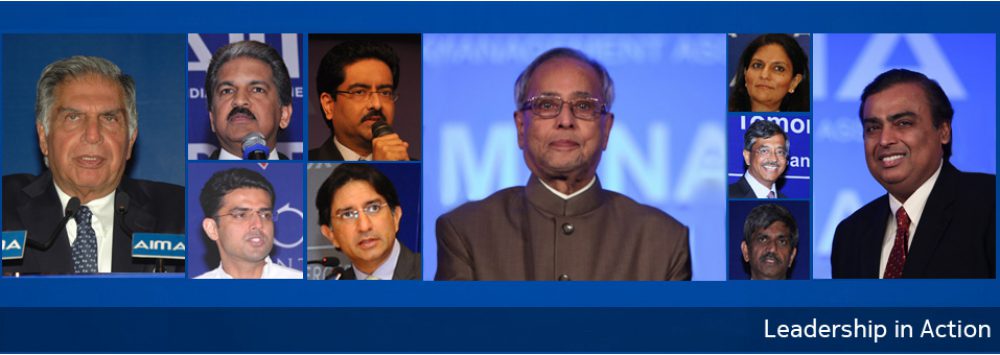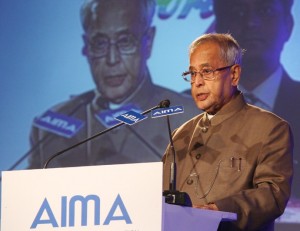At the very outset, I would like to take the opportunity of congratulating all the award winners. I am happy to join you on this happy occasion – Managing India Awards 2013. These are prestigious corporate awards that recognize outstanding contribution of individuals and organizations to Indian business management. Our country today has corporate leaders who can manage the development of Indian business into models of excellence. Indian managers are recognized all over the world for their managerial capacity. Many global business giants are headed by Indian managers and technocrats today.
Philip Kotler, the acclaimed expert on Marketing had once observed and I quote: “Today you have to run faster to stay in place” (unquote). We have set upon us a challenge to make India count amongst the top few nations in the world. To mark India’s growing stature, management principles should find application not only in our business and industry, but also in other important processes such as social change and governance. How change is managed will determine our progress. This is a need that the Managing India Awards denote, and is also a reality epitomized by this year’s award winners.
The All India Management Association, formed in 1957, has been unstinted in its promotion of management excellence in the country. It has motivated Indian enterprises to use management capability as an enabling tool for change and progress. Ladies and Gentlemen, our country’s economic prospect engages the minds of most today, more so of the corporate leaders and policy makers present here. It is true that our economic growth has declined during the last two years. It is also true that unless many of our current macro-economic indicators like price level, fiscal balance and current account balance improves, it will be difficult to revive economic growth to the 9 per cent plus levels which is absolutely imperative if we want to achieve the objective of removing poverty in the country.
But let us not forget that in the decade 2003-04 to 2012-13, the average annual economic growth of our economy was a healthy 7.93 per cent. Of this 10 year period, we have a block of 5 years, from 2008-09 to 2012-13, when the world economic growth was extremely sluggish, fragile and uncertain. Though our GDP growth in 2012-13 at 5.0 percent is the lowest in 10 years, it is much higher than the G-7 countries. International projections point out that our growth will continue to be better than these major economies for the next two years.
We had adopted a globalization strategy to usher in speedy growth. Towards this paradigm, we have progressively liberalized our trade and investment sectors. The international trade to GDP ratio of India at 44 per cent signifies the depth of our economy’s integration with the world economy. It is therefore hard to expect India’s economy to remain immune from the repercussions of a prolonged global financial crisis.
The immediate challenge before us is to reverse the deceleration in growth. It is possible for us to re-enter the 7 to 8 per cent growth bracket in the next two to three years. But for that, we must revitalize investments in the country. The high economic growth after 2003-04 was led by a spurt in investments. But from 2007-08, the investment rate has continued to decline. Tight monetary policy to contain inflation, lack of adequate procedural flexibility for projects and reduction in export demand due to global slowdown has affected private sector investment in India.
Strengthening the positive investment climate would require us to improve governance of business projects. As per an international survey, India does well in parameters like Getting Credit and Protecting Investors. But in other important sectors such as Starting a Business, Dealing with Construction Permits, Paying Taxes and Enforcing Contracts, we lag behind many of our competitors.
We must make our systems more responsive to the industry’s need for facilitation and timely clearances. It is gratifying to note that a Cabinet Committee on Investment has been constituted to monitor and review major projects in respect of various licenses and approvals for their time-bound implementation. A large amount of financial savings in our country are absorbed in meeting government deficits. Deficits should be brought down so that greater proportion of savings is available for investment. Steps for fiscal consolidation should make it possible to reduce the fiscal deficit progressively to its target of 3 per cent by 2016-17.
Ladies and Gentlemen, we must be realistic in our assessment of India’s economic prospects. The downbeat atmosphere seen these days is unwarranted. Foreign investors are positive about our economy. The net inflow from Foreign Institutional Investors at Rs. 1.6 lakh crore in 2012 is a substantial rise from the Rs. 39,000 crore in 2011. According to an important survey, India is the third most preferred destination for Foreign Direct Investment (FDI), after China and the US. Between April 2012 and January 2013, over Rs. one lakh crore have come to our economy as FDI. Our infrastructure sector has great potential to make productive use of these investments. The sectors with high linkage to infrastructure such as automobile, steel and cement, enjoy high growth in India as compared to many of her competitors.
A recovery in the advanced economies is expected in 2014 as their economic growth is projected to increase from 1.4 per cent in 2013 to 2 per cent in 2014. We should leverage this growth outlook by enhancing the competitiveness of the domestic industry, especially our export enterprises. Ladies and Gentlemen, manpower and technology are the prime drivers of industrial progress. Abundant manpower underlines India’s comparative advantage. By 2025, two-third Indians will be in the working age group. By that time, 100 million additional jobs will be required for creation in the manufacturing sector alone.
To develop our manpower as partners of progress, all-round efforts are necessary. Greater number of technical institutes is required to be set up. Existing technical institutes that lag behind in quality must be upgraded. More initiatives like the Vocational Training Improvement Project that envisaged up-gradation of 400 industrial training institutes are necessary. I am happy to note that the All India Management Association, in its continuing efforts at manpower development, has set up a Centre for Skill Development and Training.
The pool of management professionals in our country is not sufficient to meet the demand for such personnel. In 2011-12, the enrolment to commerce and management streams in the country was 34 lakh. This has to rise and for that more institutes for management education is necessary. It is gratifying to note that 7 new Indian Institutes of Management were set up during the Eleventh Plan period. The private sector should also play a pivotal role and mark their presence as a major producer of managerial manpower. Technology will determine our domestic industry’s ability to beat competition. Our research and innovation efforts must aim at technology up-gradation to simplify production processes, improve quality and seek efficiency gains. The Industry must partner with the academic and research institutions to develop solutions of wide utility for the market and the common man.
We have to do much more to be at the forefront of innovation. Only one in 50 patent applications in the world is filed in India. Our patent regime has the difficult task to sustain encouragement to innovation on the one hand and maintain market competition, and ensure accessibility and affordability, on the other.In the words of Late Peter Drucker, the renowned management thinker, “Innovation is the specific instrument of entrepreneurship- the act that endows resources with a new capacity to create wealth”. There are several grass root innovations that has the potential for development into marketable products. Our Industry should support such microinitiatives so that benefits of new and better products accrue to the society.
Ladies and Gentlemen, our country needs visionary business leaders to manage India’s transition to a knowledge economy. We also require the Indian industry to act as a catalyst for deepening our growth 6 process. Our industry should aim at inclusion of all as participants in economic development. I have an unshakable faith in our economy’s bright future. The winners of Managing India Awards exemplify this conviction. Once again, I congratulate all of them for contributing to the country’s progress. I am sure they will ignite the minds of other managers and entrepreneurs to think big towards nation building. I also wish the All India Management Association all success in their future endeavours.
Thank you.
Jai Hind.
The above article is an excerpt from the speech delivered by Shri Pranab Mukherjee, President of India at AIMA’s Managing India Award 2013 which was held in April 2013.





Mt Mukerjee shared good views about India